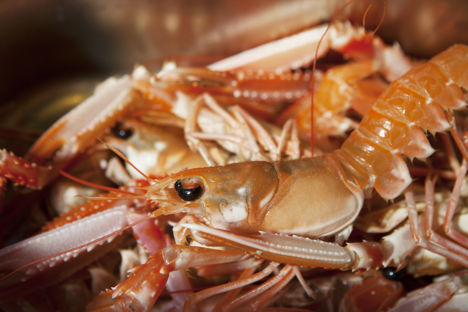Langoustines - also known as Norway lobsters or Dublin Bay prawns - are the smaller cousins of lobsters. These pink-orange crustaceans come from the cooler waters of the North Atlantic Ocean, and are a popular ingredient in Scotland, Ireland, and Norway. Incredibly versatile with a sweet flavour, they're delicious served grilled with a squeeze of lemon or tossed into pasta dishes or tomato stews.
How do I prepare langoustines?
Preparing langoustines is simpler than it might seem, and their beautiful flavour makes the effort well worth it. To start, make sure your langoustines are fresh; they should have a sweet, briny smell and their shells should be firm and bright, not discoloured or slimy. To clean them, rinse under cold water, then twist off the head if desired. For easier eating, remove the shell by peeling it away from the tail, starting at the underside. However, many recipes call for cooking them in their shells to retain flavour. Use kitchen scissors or a sharp knife to cut down the back of the langoustine and remove the digestive tract. Once cleaned, you can grill, boil, or sauté the langoustines, keeping cooking time short to preserve their tender texture.
How do I cook langoustines?
Cooking langoustines to perfection is all about preserving their delicate texture and sweet flavour. The best methods include grilling, boiling, steaming, or sautéing, each offering a slightly different but equally delicious result. To grill, simply brush them with olive oil and cook on high heat for about 2-3 minutes per side until they turn a vibrant pink. For boiling or steaming, immerse them in salted boiling water or place them in a steamer basket for 3-4 minutes, just until their shells change colour.
Sautéing in a hot pan with a bit of butter or oil takes only 2-3 minutes per side. To avoid overcooking, keep a close eye on the colour change and texture; overcooked langoustines can become rubbery. The key is to cook them just until they are opaque and firm, yet still tender and juicy. Always err on the side of slightly undercooking, as the residual heat will finish the job.
How do I eat langoustines?
Start by separating the head from the tail with a gentle twist. To open the shell, hold the tail with the underside facing up and use your thumbs to crack it open by pressing along the shell's soft, segmented belly. Gently peel the shell away from the meat, which should come out in one piece. If there's too much resistance, kitchen scissors can help by cutting down the back of the shell. At times shelling langoustines can be a hands-on and messy affair, but it's well worth it.
Simple buttered langoustines recipe
Metric
Imperial
- 500g of langoustines
- 100g of unsalted butter
- 2 garlic cloves, minced
- 1 tbsp of lemon juice
- 1 tbsp of fresh parsley, chopped
- salt and pepper to taste
Rinse the langoustines under cold water and pat them dry with paper towels
If desired, remove the heads and shells as described in the cleaning instructions above. Alternatively, you can cook them whole
In a large pot, bring salted water to a boil. Add the langoustines and cook for 3-4 minutes until they turn a bright pink colour
Drain the langoustines and set them aside.
In a large skillet, melt the butter over medium heat
Add the minced garlic and cook for 1-2 minutes until fragrant, but not browned
Stir in the lemon juice and chopped parsley
Add the cooked langoustines to the skillet and toss to coat them evenly with the butter sauce
Season with salt and freshly ground black pepper to taste
Transfer the buttered langoustines to a serving platter, garnish with extra parsley if desired and serve immediately with crusty bread or a side salad
How do I store cooked langoustines?
To store cooked langoustines, place them in an airtight container and refrigerate within two hours of cooking. They will last in the refrigerator for 2-3 days. To ensure they stay fresh, keep them at a consistent cold temperature and avoid leaving them out at room temperature for extended periods. If you want to extend their shelf life, you can freeze the cooked langoustines.
How can I freeze cooked langoustines?
First allow them to cool completely after cooking. Then, spread the langoustines in a single layer on a baking sheet and place in the freezer for a few hours to freeze them. Once frozen, transfer the langoustines to a freezer-safe bag or container, removing as much air as possible to prevent freezer burn. Properly stored in the freezer, cooked langoustines can last 2-3 months. When you're ready to eat them, thaw the langoustines in the refrigerator overnight and reheat gently to maintain their delicate texture and flavour. Freezing helps preserve the quality of the langoustines, allowing you to enjoy them at a later date without compromising on taste.
Langoustine recipes
Langoustines' sweet flavour and tender texture make them perfect for everything from a quick, buttery sauté to a more elaborate dish. Next time you're in the mood for something a extra special, give one of our langoustine recipes a go, like Emauele Scarello’s langoustines with aubergine, seaweed and fusilloni or Paul Welburn’s chargrilled langoustines, bisque, buttermilk and pickled fennel.
Get in touch
Please sign in or register to send a comment to Great British Chefs.



